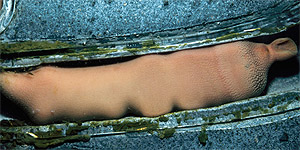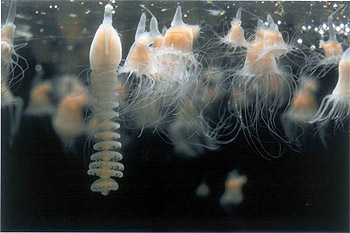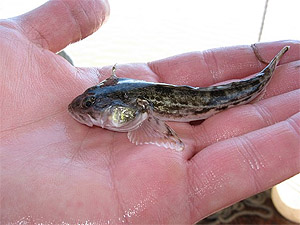
|
|||||||||||||||
|
| |||||||||||||||
Algae and wetland plants put on new growth, providing food for spawning animals Like the ocean, coastal wetlands such as Elkhorn Slough also become more productive in spring, when increasing sunlight warms the air and water and allows plants and algae to put on new growth. In shallow areas, eel grass (Zostera marina), a wide-bladed relative of the surf grass found in tidepools, sends up new shoots from buried rhizomes. Eel-grass beds provide essential habitat for worms, crabs, and young fish. Blooming algae provide food for copepods and young fish as well as other small animals that spawn in estuaries during spring. Debris from the rapidly growing plants and algae in the estuaries also provide food for the multitudes of filter-feeders that live in the muddy bottom. Fat innkeeper worms spawn  A fat innkeeper worm (about one foot long). (Source: Monterey Bay Aquarium) One of the most abundant bottom-dwelling animals in the slough is the fat innkeeper worm (Urechis campo). Like many bottom-dwelling animals, the fat innkeeper worm is not much to look at--its foot-long body resembles a large, pink sausage. However, it is well adapted to life in the slough, and spends virtually all of its life pumping water through its large, U-shaped burrow and filtering tiny food particles out of this water with a mucus net. Although fat innkeeper worms may spawn at any time of year, they seem to be most sexually active in spring. During spawning, male innkeeper worms release puffs of whitish sperm from their burrows, while female worms release clouds of pinkish, yellowish, or light green eggs. Fertilized innkeeper-worm eggs develop into tiny swimming larvae that begin feeding on phytoplankton when they are a couple of days old. These larvae spend about two months as plankton, after which they return to the muddy bottom of the slough, where they burrow in and settle down for the rest of their lives. As its name suggests, the fat innkeeper worm's claim to fame is its willingness to share its burrow with other animals. Typical "guests" include a scale worm, two different types of crabs, several small fish (gobies), and a clam that tunnels into the side of the innkeeper worm's burrow. Many of these animals are uniquely adapted to life within the innkeeper worm's burrow, and feed on bits of food that are trapped by the host's mucus net but are too large for the innkeeper worm to eat. An entire book could be written about the innkeeper worm and its odd little tenants, some of whom would eat their neighbors, given half a chance. Animals that live in fat innkeeper worm burrows also spawn It is interesting that some of the fat innkeeper worm's tenants spawn at more or less the same time as their landlord. For example, the fat innkeeper scale worm (Hesperonoe adventor) typically spawns in March. This scale worm is one of the innkeeper worm's most dedicated tenants, as indicated by its species name (adventor), which means "guest at an inn" in Latin. This two-inch-long scale worm can usually be found snuggled up right next to its host, facing the same direction and sometimes eating directly from its host's mucus web (as well as feeding on small animals and organic material pumped through the burrow). Once established in a burrow, the scale worm can be very possessive of its cozy setup, and will kill and sometimes eat other scale worms that try to horn in on its living space. But life is not always easy, even for a "freeloader" such as the fat innkeeper scale worm. One reason the scale worm must stay close to its host is to avoid being eaten by a type of small pea crab (Scleroplax granulata) that also lives the burrow. Up to six of these quarter-inch-wide crabs may share a single fat-innkeeper-worm burrow. When not chasing scale worms, fat innkeeper worm pea crabs feed on bits of animal flesh, drifting debris, and plankton that are flushed through the burrow and missed or rejected by the innkeeper worm. Like the scale worm, the pea crabs also seem to reproduce in spring-at least they are most often seen carrying eggs between February and April. Giant mud worms spawn If the fat innkeeper worm seems a bit grotesque, it is nothing compared with the giant mud worm (Neanthes brandti), which also lives in Elkhorn Slough and spawns in spring or early summer. This impressive animal grows up to three feet long, but can stretch to twice this length under stress (for example, when a marine biologist is trying to pull it from its lair). Young giant mud worms apparently eat green algae such as Ulva and Enteromorpha, which are abundant in the slough. The adults, with their two- to three-inch diameter bodies, stay in their burrows most of the time, and are seldom seen except when they leaves their burrows to spawn. Before spawning, each giant mud worm undergoes a werewolf-like metamorphosis. Instead of growing excessive facial hair, the mud worm grows new swimming and reproductive organs and changes into what marine biologists call an "epitoke." Giant mud-worm epitokes can also swim quite rapidly--one (perhaps startled) scientist described them as "covering several feet a second in rapid wriggling motions." Giant mud worms spawn at night. When conditions are right, thousands of male and female epitokes leave their burrows and form huge writhing masses on the surface of the slough. The sight of these thrashing orgies of three-foot-long worms in the dark waters of the slough reminded Ed Ricketts (the marine biologist made famous as "Doc" in Steinbeck's Cannery Row) of a nightmare or the hallucinations of delirium tremens. Gaper clams spawn  A gaper clam (about ten inches long). (Source: Oregon Department of Fish and Wildlife) Another large mud-dweller that spawns in spring is the gaper clam (Tresus nuttallii). Although these clams may spawn at other times of year, they are most likely to do so when water temperatures start to drop between February and April (due to upwelling). The gaper clams lives in deep burrows that often extend three to four feet into the mud. It has a huge siphon that may grow to over six feet long--too long to fit inside the clam's shell (thus its common name). At the tip of this siphon are two horny plates that the clam uses to close the entrance to its burrow. These plates provide a hard surface in the otherwise soft, muddy bottom, and are often colonized by other plants and animals. In fact, about 50 different species of animals and eight species of algae have been reported growing on the siphons of gaper clams. Blue mud shrimp spawn Yet another slough dweller that spawns in early spring is the blue mud shrimp (Upogebia pugettenis). An alternative common name for this animal might be the "fat innkeeper shrimp." Like the fat innkeeper worm, a mated pair of blue mud shrimp shares their six-foot-long, branching burrow with pea crabs, snapping shrimp, clams, worms, copepods, and sometimes gobies. Blue mud shrimp lie in their burrows and kick their legs to create a current of water, from which they filter plankton and other food particles using their luxuriant leg hairs. These shrimp are such homebodies that they will die if their bodies are not kept in continual contact with the walls of their burrow. Female blue mud shrimp are often found carrying eggs between December and April. During this time, the female uses her hairy legs to keep the eggs clean and well oxygenated. Moon jellies strobilate While giant worms go through their mating frenzies and brooding mud shrimps fastidiously clean their eggs, the polyps of the moon jelly (Aurellia aurita) engage in a more elegant and refined method of reproduction. If you wade out into the waters of Elkhorn Slough in February or early March and look closely at the wave-sheltered sides of submerged rocks, you may find tiny moon-jelly polyps that look like miniature, ivory-colored sea anemones.  Jellies strobilating (in an aquarium) (Source: Monterey Bay Aquarium) These polyps have spent the winter in the slough, feeding on copepods and other tiny crustaceans, and growing from about 1/8 inch tall to about 1/2 inch tall. In February or early March, they "strobilate," their bodies becoming segmented until they look like tiny stacks of tea saucers. When conditions are right [what are these conditions?] the little segments of the polyp begin to break off, one at a time, from the end of the stalk. As soon as a segment breaks off, it becomes a miniature moon jelly (a medusa) and swims away with little pulses of its delicate bell. If it survives, the little moon jelly will eventually leave Elkhorn Slough and head out to sea. Staghorn sculpin and herring larvae hatch While the worms, shrimps, and jellies of the slough are just getting started in their reproductive activities during March, some fish in the slough have been at it for a month or more. Coastal estuaries such as Elkhorn Slough serve as nursery areas for a wide variety of fish, with different species using the slough at different times of year. Some of these fish, such as the staghorn sculpin, are year-round residents in the slough. Many others, including pacific herring and a variety of flatfish, are oceanic species that only come into the slough at certain times of year to spawn or feed. Young fish in the upper reaches of the slough are generally well fed on copepods, worms, small shrimp-like crustaceans, and algae that grow in the warm, nutrient-rich water. In addition, the young fish may be sheltered from some larger predators in the shallow, muddy waters of the upper slough. With plenty of food and warm water, the young fish grow rapidly, which increases their chances of survival when they the leave the slough for the predator-filled open ocean. When spring progresses into summer, pulses of juvenile fishes will move out from the creeks and shallow areas of the slough and into the main channel, then out into the open bay and coastal areas. When they leave, these fishes carry the bountiful primary production of the slough out into the open bay. Staghorn sculpin hatch  A young staghorn sculpin. (Source: Amber Manfree/UC Davis ) Staghorn sculpin (Leptocottus armatus) are the most common fish in the small creeks and shallow areas of Elkhorn slough. They also live in sandy-bottom areas throughout Monterey Bay. In winter, adult staghorn sculpin from outside the slough migrate to the shallow upper reaches of the slough, where they lay eggs in February or March. Newly-hatched staghorn sculpin larvae first appear in the upper portions of Elkhorn Slough in March. These young fish remain in the slough, eating copepods and small worms, until they reach maturity in July. At this point, some of them migrate out of the slough to live in holes in the sea floor. Others remain within the slough, living in burrows in the small tidal creeks where they were born. Pacific herring hatch  Herring larva (Source: Fisheries Canada) Pacific herring (Clupea pallasii) also spawn in the upper reaches of Elkhorn Slough, typically laying eggs in beds of eel-grass or patches of the hair-like red algae Gracilariopsis during December or January. By February and March, the herring eggs have hatched, releasing millions of tiny herring larvae that are busy swimming around the slough. As March progresses, these larvae begin developing into juveniles. The juvenile herring will hang around the slough for another month or two, gorging on copepods, before heading out into the open waters of Monterey Bay. Large schools of herring also spawn in San Francisco Bay from November through February. After spawning, the adults (who are weak from putting their energy into sex instead of into eating), begin to leave the bay in March, heading out to a feeding area just outside the Golden Gate. However, schools of king salmon also congregate in this area in early spring, where they feed voraciously on the weakened herring. Predatory fish enter estuaries to hunt for young fish and invertebrates Soon after the young sculpin and herring hatch in coastal estuaries, open ocean fish venture into coastal estuaries to prey on the young fish and other animals that use the slough for a nursery. Juvenile California halibut (Paralichthys californicus) and starry flounder (Platicthys stellatus) appear in Elkhorn Slough primarily between February and April. The juvenile halibut feed mostly on other fish, especially young anchovies and arrow gobies. Juvenile flounder, on the other hand, prefer smaller prey such as amphipods and worms. Other young predatory fish, including California tonguefish, striped bass, threadfin shad, and English sole, also enter the slough to feed during spring. Most of these hungry young fish stay in the slough for just a few months before heading back out to sea. The adults of these species are rarely seen in the slough, but slough waters provide an important source of food for the young fish. |
